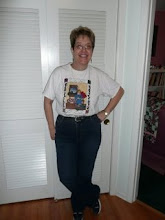 This evening I sewed a sleeve onto the second of the antique quilts. This is a silk crazy quilt from the 1890's - at least I think that's what Rick said. This quilt has very thin batting. The backing was placed right sides together with the top, sewn all around to encase the batting, turned right side out, and then machine stitched very close to the edge. As is typical of crazy quilts it is not quilted. Many crazy quilts were tacked together invisibly in various
This evening I sewed a sleeve onto the second of the antique quilts. This is a silk crazy quilt from the 1890's - at least I think that's what Rick said. This quilt has very thin batting. The backing was placed right sides together with the top, sewn all around to encase the batting, turned right side out, and then machine stitched very close to the edge. As is typical of crazy quilts it is not quilted. Many crazy quilts were tacked together invisibly in various  places to keep the backing in place - this one was not. The backing, which is a loosely woven, almost gauzy type print has actually turned to the front along at least one edge. What's interesting is that at some time - I'm guessing later than the quilt was made - someone sewed a row of machine stitching from just inside the edge to almost half way down into the quilt. The stitching goes all the way through, so the lining is sewn down to the top along his line. The stitching simply stops for no apparent reason part of the way down the quilt. I wish the quilt could talk - I'd love to know who sewed that row of stitching and why. It certainly wasn't to prevent the back from turning to the front
places to keep the backing in place - this one was not. The backing, which is a loosely woven, almost gauzy type print has actually turned to the front along at least one edge. What's interesting is that at some time - I'm guessing later than the quilt was made - someone sewed a row of machine stitching from just inside the edge to almost half way down into the quilt. The stitching goes all the way through, so the lining is sewn down to the top along his line. The stitching simply stops for no apparent reason part of the way down the quilt. I wish the quilt could talk - I'd love to know who sewed that row of stitching and why. It certainly wasn't to prevent the back from turning to the front  because it was no where near an edge. It also starts about 1-2" from an edge, and whoever stitched it didn't smooth out the back before they started - the back is bunched in wrinkles between the start of the stitching and the edge of the quilt. The fabric is disintegrating in places as is also typical of crazy quilts - the metals used to weight the silk were corrosive, causing the fabric to disintegrate. All the seams are covered with simple embroidery stitches in
because it was no where near an edge. It also starts about 1-2" from an edge, and whoever stitched it didn't smooth out the back before they started - the back is bunched in wrinkles between the start of the stitching and the edge of the quilt. The fabric is disintegrating in places as is also typical of crazy quilts - the metals used to weight the silk were corrosive, causing the fabric to disintegrate. All the seams are covered with simple embroidery stitches in  many different colors of thread - feather stitching, herringbone, and cross stitch. It is very nicely done - obviously by an accomplished needlewoman.
many different colors of thread - feather stitching, herringbone, and cross stitch. It is very nicely done - obviously by an accomplished needlewoman.I'm looking forward to seeing these quilts on display so I can read any information they have about each one. The accession tags are tied to the wrappings on each quilt but no information about any of the quilts came along to me with them.
 I feel so honored to be able to touch these quilts and preform this service for the Interpretive Center. It makes me feel such a close kinship with our foremothers who plied their needle as much out of necessity as for pleasure.
I feel so honored to be able to touch these quilts and preform this service for the Interpretive Center. It makes me feel such a close kinship with our foremothers who plied their needle as much out of necessity as for pleasure.


4 comments:
I understand that feeling of connection as you work on someone elses quilt. I know someone up there is smiling down on you!
What an honor...that crazy quilt is absolutely gorgeous. Thank you for sharing these. What a treat.
I'm so lucky that you're sharing these lovely quilts with me (and other people, I think, lol!) British quilts typically had no binding, and were sewn with the edgea turned under (as I'm sure you know). It's the clever Americans who first started binding their quilts. This one has a gorgeous set of pinks and browns as its colour scheme, either from a very coordinated wordrobe or a plan!
It is such a wonderful connection to the past . . . like the bowls, there's a story to tell - but one we won't know. All we can do is add to the story.
Post a Comment